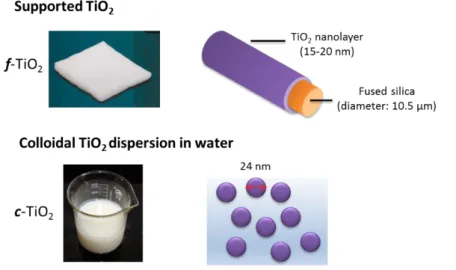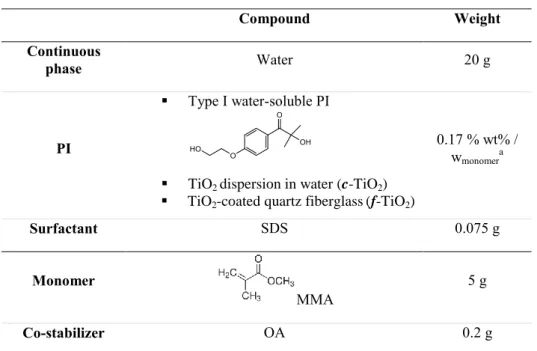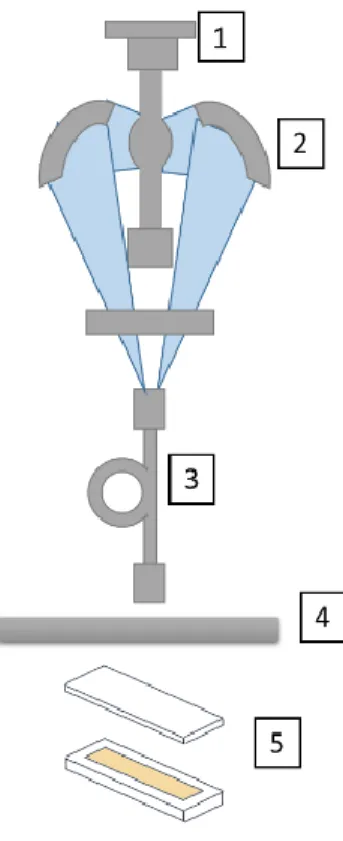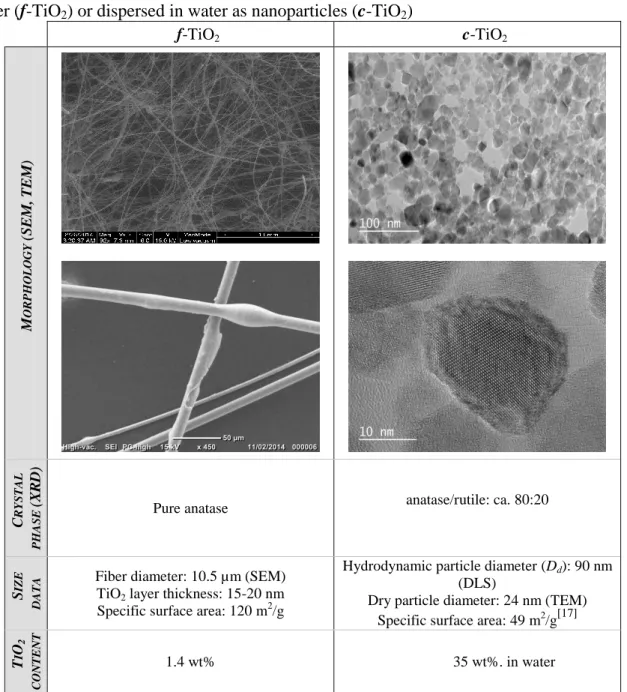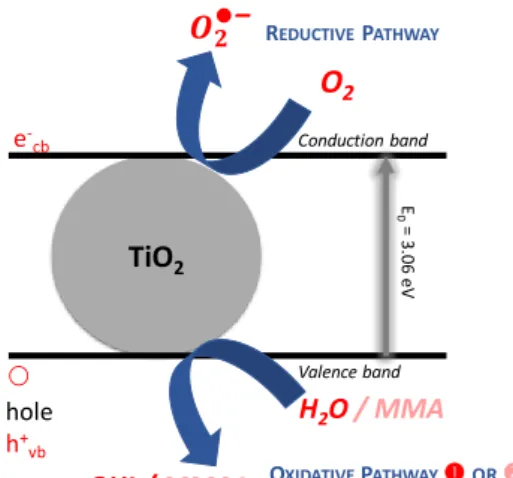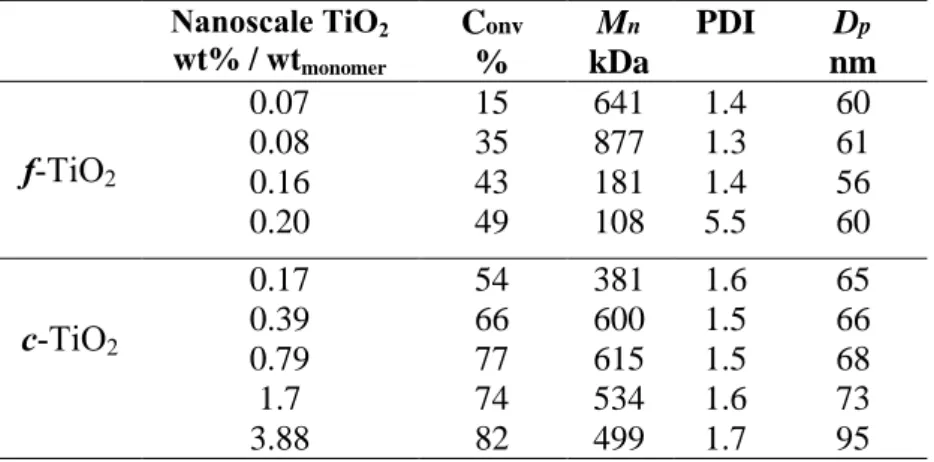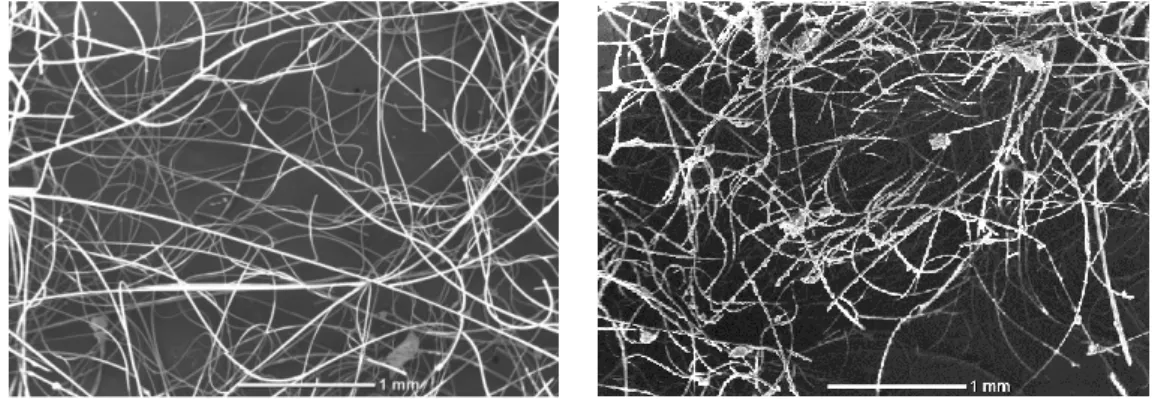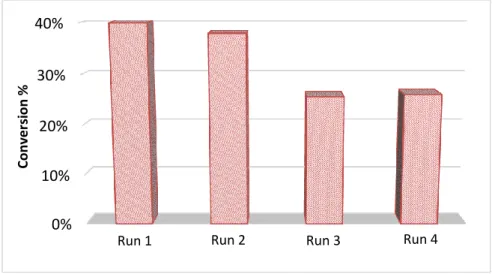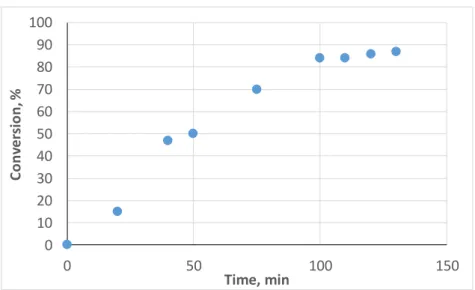HAL Id: hal-02442169
https://hal.archives-ouvertes.fr/hal-02442169
Submitted on 16 Jan 2020HAL is a multi-disciplinary open access archive for the deposit and dissemination of sci-entific research documents, whether they are pub-lished or not. The documents may come from teaching and research institutions in France or abroad, or from public or private research centers.
L’archive ouverte pluridisciplinaire HAL, est destinée au dépôt et à la diffusion de documents scientifiques de niveau recherche, publiés ou non, émanant des établissements d’enseignement et de recherche français ou étrangers, des laboratoires publics ou privés.
and Recyclable Photocatalysts for Radical
Polymerizations in Aqueous Dispersed Media
Emeline Lobry, Abdoul Salam Bt Bah, Loïc Vidal, Esther Oliveros, André
Braun, Adrien Criqui, Abraham Chemtob
To cite this version:
Emeline Lobry, Abdoul Salam Bt Bah, Loïc Vidal, Esther Oliveros, André Braun, et al.. Colloidal and Supported TiO 2 : Toward Nonextractable and Recyclable Photocatalysts for Radical Polymerizations in Aqueous Dispersed Media. Macromolecular Chemistry and Physics, Wiley-VCH Verlag, 2016, 217 (20), pp.2321-2329. �10.1002/macp.201600150�. �hal-02442169�
DOI: 10.1002/macp.
Article Type: Full Paper
Colloidal and Supported TiO
2: Towards Non-Extractable and Recyclable
Photocatalysts for Radical Polymerizations in Aqueous Dispersed Media
Emeline Lobry, Abdoul Salam BT Bah, Loïc Vidal, Esther Oliveros, André M. Braun, Adrien Criqui, Abraham Chemtob*
–––––––––
Dr. E. Lobry, A. S. BT Bah
Laboratory of Macromolecular Photochemistry and Engineering University of Haute-Alsace
3 rue Alfred Werner, 68093 Mulhouse Cedex, France
Dr. E. Oliveros
Laboratoire des Interactions Moléculaires et Réactivité Chimique et Photochimique (IMRCP), UMR 5623-CNRS/UPS
Université Toulouse III Paul Sabatier
118, route de Narbonne, 31062 Toulouse Cedex 9, France.
Dr. A. M. Braun Engler-Bunte-Institute
Karlsruhe Institute of Technology 76131 Karlsruhe, Germany
Dr. A. Criqui Mäder Research MADER GROUP
130 rue de la Mer Rouge, 68200 Mulhouse, France
Dr. A. Chemtob, Loïc Vidal
Institut de Science des Matériaux de Mulhouse CNRS UMR 7361
University of Haute-Alsace
15 rue Jean Starcky, 68057 Mulhouse, France E-mail: abraham.chemtob@uha.fr
––––––––– *
Corresponding author: Tel: +33 3 89 60 88 04; abraham.chemtob@uha.fr
–––––––––
Two high surface area titania forms, dispersed as stable nanoparticles or coated on fused silica
microfiber, are used as non-leachable photocatalysts for the radical photopolymerization of
methyl methacrylate miniemulsion in water. At low loading (0.17 wt% / wtmonomer), both
nanoscale TiO2 yield ca. 50% conversion after 10 min UV irradiation, compared to 63% with
a conventional type I photoinitiatior (hydroxyacetophenone). High-molecular-weight values
(> 180 kDa) and a polydispersity index of about 1.5 are achieved, indicating that undesirable
degradation is negligible. In the proposed mechanism, a surface initiation takes place through
the generation of hydroxyl radicals from H2O oxidation. We show that irradiance and TiO2
content are two key parameters for controlling molecular weight and conversion values. The
supported TiO2 form can be easily recovered and reused up to 4 times, despite a gradual
reduction in conversion. Deposited on the wall of the annular photochemical reactor, it
enables reaction scaling-up.
FIGURE FOR ToC_ABSTRACT
Acrylate miniemulsion UV light irradiation
HO
TiO2layer Fused silica microfiber 2. COLLOIDALTIO2 1. SUPPORTEDTIO2 Hydroxyl initiating radical Acrylic latex1. Introduction
Issues including initiator odor, toxicity, migration and contamination, which may affect the properties or uses of polymer products, are currently at the centre of public debate, especially in the context of consumer and worker protection. The problem is particularly acute in UV-curing technology, which is used for the large-scale production of industrial coatings, adhesives, inks and other photosensitive materials.[1,2] Free radical UV-curing is characterized
by sub-second cycle times and the need of high photoinitiator (PI) concentrations to overcome oxygen inhibition, especially in fields such as the printing industry. This leads to a significant amount of non-reacted PI remaining in cross-linked films. Due to their low-molecular-weight, PIs are able to migrate within the film network, and may extract from the surface. In the field of food packaging, this mechanism may result in contamination, and spawned the important food product scandals of recent years which have permanently affected the consciousness and driven more stringent regulations.[3]
At present, the main response of the industry concerns the development of polymer initiating systems based on oligomeric type II PIs, hence avoiding the release of low-molecular-weight photoproducts. These initiating systems typically involve a couple of non-migratory oligomeric photosensitizers (based on thioxantone or benzophenone[4]) and a hydrogen donor
(polymeric amine) generating initiating species of high-molecular-weight.[5] However, these
“polymeric” PIs involve additional cost, lead to higher viscosities of the UV-curable formulations, and decrease polymerization reactivity when used at similar weight ratios as
low-molecular-weight analogues.
To overcome these limitations, semiconductor nanoparticles have been recently presented as potential non-migrating radical photoinitiators.[6] However, the capacity of semiconductors
such as TiO2, ZnO or CdS to act as initiator of radical photopolymerization was already demonstrated several decades ago.[7–12] Today, nanoscale semiconductor particles, especially
TiO2-photocatalysis is induced by the generation of excitons (electron-hole pairs) upon absorption of UV-radiation by the semiconductor leading to redox reactions of compounds adsorbed at the particles surfaces, e.g. molecular oxygen (O2) and/or water. The resulting reactive oxygen species (ROS), i.e., hydroxyl radical (HO.) cause oxidation and subsequent mineralization of organic contaminants present in water or air.[15] Superoxide radical anion
(O2.-), generated by the reduction of O2, might act as a reductant but is not known to induce subsequent radical reactions. Based on the premise that some ROS, such as HO., might initiate radical polymerizations, Kraeutler et al. demonstrated as early as 1979 that fumed TiO2 could replace a PI when dispersed in an organic solvent containing methyl methacrylate (MMA).[16] Mechanistically, it might be assumed that the holes of the electronically excited
TiO2 react by electron transfer with an alcohol (ROH) or a carboxylate (RCOO-) added as
co-initiator, thus generating C-centered radicals (R.) either by loss of a proton (primary or secondary ROH) or by loss of CO2 from the intermediary RCOO.. Such initiating systems based on a semiconductor nanoparticle/coinitiator tandem have attracted considerable interest in radical photopolymerization.[17–25] Nevertheless, non-reacted co-initiators may be prone to
migration in contrast to nanometer scale semiconductor particles that are not supposed to diffuse in the polymer network. Alternative pathways involving semiconductor nanoparticles proceeded by photoinduced electron transfer to transition metal ions to trigger atom-transfer radical polymerization (ATRP)[25,26] or bulk radical polymerization using surface Pt(II), Cu(II)
or Fe(III) modified ZnO nanoparticles.[6]
Yet, the simplest method to avoid the formation of residual migrating species is probably to
rely on hole oxidation of water to create initiating hydroxyl radicals (HO.) that are known to
be very effective for the oxidation of organic compounds in aqueous solution. The first TiO2
-photocatalyzed polymerization studies were performed in aqueous solution using dispersed
monomers (acrylamide,[8,24,27] acrylic acid[27] or methacrylic acid[28]) or partially water-soluble
monomers (MMA).[22,29,30]
Given that most utility monomers are insoluble in water, we suggest that polymerization in
aqueous dispersed media may be a more convenient and versatile system to perform
nanoscale TiO2-photoinitiated polymerizations without generation of migrating
photoproducts. Currently, polymerization in dispersed media accounts for nearly 20% of the
worldwide polymer production, and encompasses a number of distinct processes. Mainly
suspension and emulsion processes have been used industrially to produce some of the most
important commodity thermoplastics, including poly(vinyl chloride) or styrene-acrylic
polymers. Recently, Song et al. showed that solid TiO2 nanoparticles can act both as
photocatalyst and Pickering stabilizer (by adsorption on droplet surface) in emulsion
polymerization of styrene.[31,32]
Keeping this study in mind, we investigated in a first step a model MMA miniemulsion to confirm the feasibility of a TiO2-photoassisted polymerization in an aqueous dispersed medium. But in all likelihood, this approach may be applied to a range of aqueous monomer emulsions. By a careful control of the amount of added TiO2 and the conditions of irradiation, we could show that the production of high-molecular-weight acrylic latex can be achieved without substantial chain degradation. In this work, two nanoscale TiO2 forms have been investigated, as depicted in Figure 1: colloidal dispersion and nanosized layer coated on
fused quartz fiber. Both systems have specific advantages, and their initiating efficiencies
have been compared to that of a conventional water-soluble type I PI.
1. Colloidal TiO2 offers significant process advantages: direct addition to any aqueous
monomer dispersion without emulsification or dissolution stage, high surface-to-volume ratio to ensure optimal reactivity, and small average particle diameter (≈ 30 nm) to limit scattering and attenuation of UV radiation. However, the catalyst cannot be extracted after the latex
synthesis stage. This raises concern on the UV photostability of the final product (waterborne coating or adhesive), in particular for outdoor applications.
2. TiO2-coated quartz fiber can act as a “supported” catalyst.[33] Quartz fibers offer an inert
and UV transparent support, while the thin TiO2 layer deposited on the micrometric fiber may provide a specific surface area for an optimal contact with the monomer emulsion and high reactivity. Supported TiO2 may be seen as a promising avenue for recoverable and reusable PIs, lessening the environmental footprint of photopolymerization reactions. The main challenge is the risk of fouling of the fiber surface during photopolymerization, suppressing the photocatalytic activity.
Figure 1. Supported and colloidal TiO2 as photocatalysts for photoinitiation of radical polymerization of monomer aqueous emulsions
2. Materials and methods
2.1. Materials
Technical grade methyl methacrylate (MMA) was purchased from Aldrich and used without
further purification. Octadecyl acrylate (OA, Aldrich) was employed as co-stabilizer of
monomer miniemulsions and sodium dodecyl sulfate (SDS, Aldrich) was used as a surfactant
for preparing the MMA miniemulsions. Distilled water was used in the preparation of the
miniemulsions. Used for comparison, the conventional type I water-soluble PI, Irgacure 2959
Specialty Chemicals. Nanoscale titanium dioxide was used in two different forms, (i) as a
dispersion in water (33-37 wt%, specific surface area of 49 m2/g) produced by Buehler and
sold by Aldrich. According to manufacturer information, this stable colloidal dispersion has
an average diameter lower than 30 nm, and 90 % of the size distribution lies below the
threshold value of 150 nm. (ii) as a TiO2-coated fused silica fiber provided by Saint Gobain
(Quartzel® PCO). Currently used for air or water treatment, this product consists of a felt composed of entangled fiberglass with a nominal TiO2 thickness of 15-20 nm, and a specific surface area of ca. 120 m2/g.
2.2. Miniemulsion photopolymerisation
The formulation of the 20 wt% solids content monomer miniemulsion is described in Table 1.
In a typical procedure, an organic phase was first prepared by dissolving the co-stabilizer
(OA, 4 wt% / wtmonomer) into the monomer. The latter was then added to an aqueous SDS solution (2 wt% / wtmonomer). Both phases were then stirred during 10 min at 700 rpm. The resulting coarse macroemulsion was then sonicated during 5 min using a Branson Sonifier
450 (450 W/L) (9 output control, 80 % duty cycle) while maintaining the stirring. The PI was
introduced differently depending on its structure. The water-soluble type I initiator or
colloidal TiO2 were simply added to the aqueous phase before the emulsification stage. As
regards to the TiO2-coated fiber glass, the fabric was introduced in the reactor vessel
containing the monomer miniemulsion just before irradiation. In the three cases, the weight
concentration of the photochemically reactive substance (molecular PI or TiO2) was kept
constant with respect to the monomer content in order to enable comparison. Regarding
c-TiO2, the concentration in TiO2 can be easily deduced from the solids content value. For
f-TiO2, the mass content was estimated based on the TiO2 weight content compared to the total
Table 1. Miniemulsion formulation Compound Weight Continuous phase Water 20 g PI Type I water-soluble PI 0.17 % wt% / wmonomera
TiO2 dispersion in water (c-TiO2)
TiO2-coated quartz fiberglass(f-TiO2)
Surfactant SDS 0.075 g
Monomer
MMA
5 g
Co-stabilizer OA 0.2 g
a The concentration is that of the active substance: type I PI or TiO
2 in the case c-TiO2 and f-TiO2
Figure 2 depicts the photopolymerization set-up. The reaction was performed in a 1 mm-thick
quartz rectangular cell (340 µL) without stirring and without degassing except when explicitly
mentioned. Polychromatic irradiation was applied vertically using a focused beam generated
by a medium-pressure Hg-Xe arc lamp (Hamamatsu L8252, 365 nm reflector, 200 W)
coupled to a flexible light-guide. Adverse effects from heat (IR radiation) were removed by a
365 nm elliptical cold reflector. Irradiation below 310 nm was removed using a glass filter to
avoid self-initiation of acrylate monomers. An irradiance of 430 mW cm–2 for the spectral
range 310–600 nm was measured by a radiometer (Ocean Optics HR4000 spectrometer) at the
surface of the sample at full opening of the diaphragm. The light was tuned by varying the
Figure 2. Experimental set-up for miniemulsion photopolymerization 1. Medium pressure
Xe-Hg arc lamp, 2. Long-wave elliptical reflector, 3. Light guide, 4. Glass filter, 5. Spectroscopic cuvette with an optical path of 1 mm containing the miniemulsion
A scale-up of the f-TiO2-induced photopolymerization was performed in batch using an
annular photochemical reactor (Peschl Ultraviolet®). A standard medium pressure Hg arc lamp (Heraeus Noblelight TQ 150, arc length: 4.4 cm) emitting a series of rays from 250 nm to 600 nm is used for irradiation. The lamp is housed in a fused borosilicate sleeve to avoid irradiation at wavelengths below 310 nm. Because of the important IR-emission of the lamp, an external cooling jacket keeps the photoreactor contents at a temperature between 20 and 25 °C throughout the polymerization reaction. The combination of lamp, sleeve and cooling device is introduced into the cylindrical reactor vessel made of borosilicate accommodating up to 120 mL of monomer miniemulsion. The distance between the two annular sections (external sleeve wall and inner reactor wall) is 9 mm and defines the optical path length. Magnetic stirring of the miniemulsion is maintained throughout the photochemically initiated polymerization. Samples were drawn during polymerization to determine conversion.
The average diameter of the monomer droplets (Dd), latex particles (Dp) and colloidal TiO2
particles were measured by dynamic light scattering (DLS) using a Zetasizer nano ZS (Malvern Instruments). Conversion was assessed by gravimetric analysis. Molecular weights of the different latexes prepared were determined by size exclusion chromatography by using a PL-gel mixed D (5 µm, 300 mm 7.5 mm) Shimadzu column calibrated with polystyrene. The molecular weights provided are then given in polystyrene equivalent. Both types of TiO2 were characterized by X-ray diffraction (XRD, Philips X’Pert Pro PAnalytical). Transmission electron microscopy (TEM) was carried out on a Philips CM200 microscope operating at 30 kV. Scanning electron microscopy (SEM) was carried out on a Jeol JCM 6000 microscope operating at 15 kV. Quartzel® fibers were analyzed before and after photopolymerization and the TiO2 content was measured by EDX.
3.
Results and discussion
3.1. Characterization of colloidal and supported nanoscale TiO2
Colloidal TiO2 (c-TiO2) and TiO2-coated fiberglass (f-TiO2) were characterized by a range of
techniques prior to their use. All data are summarized in Table 2. Concerning the morphology
of f-TiO2, the SEM analysis showed an entangled, curly continuous fiber structure displaying
a mean fiber diameter of 10.5 µm. Fiber surface appeared smooth and default-free, i.e.
without any area non-covered by the titanium dioxide layer (15-20 nm thickness according to
the manufacturer). EDX analysis revealed a TiO2 concentration of 1.4 wt% (see Figure S1 in
Supporting Information). TEM analysis of c-TiO2 showed an ensemble of non-spherical
particles that are roughly 24 nm in diameter. In contrast, DLS showed a much greater
(hydrodynamic) average diameter (90 nm). TEM provides information about particles which
are dehydrated and immobilized on a solid support. This can lead to structural distortions
compared to the solvent swollen state of DLS analysis. Discrepancy between DLS and TEM
TiO2 are prone to aggregation due to strong Van der Waals interactions. Additionally, TEM
provides information about the high crystalline structure of the individual nanoparticles. The
two main physico-chemically distinct polymorphs of TiO2 are anatase and rutile. The precise
crystalline phase was determined by XRD analysis (see Figure S2 of SI): c-TiO2 has a pure
anatase structure that is known to have a higher photocatalytic activity than rutile but is
thermodynamically less stable.[34,35] By contrast, the XRD pattern of f-TiO2 revealed a
coexistence of the two different crystallographic forms rutile/anatase in the ratio: ca. 80:20 %.
Table 2. Main characteristics of the two nanoscale TiO2, either coated on amorphous silica fiber (f-TiO2) or dispersed in water as nanoparticles (c-TiO2)
f-TiO2 c-TiO2 M O R PHO LO G Y (SE M, T E M) C R YSTAL PHA S E (X R D)
Pure anatase anatase/rutile: ca. 80:20
S
IZE
D
A
TA
Fiber diameter: 10.5 µm (SEM)
TiO2 layer thickness: 15-20 nm
Specific surface area: 120 m2/g
Hydrodynamic particle diameter (Dd): 90 nm
(DLS)
Dry particle diameter: 24 nm (TEM)
Specific surface area: 49 m2/g[17]
T I O2 C O N TE N T 1.4 wt% 35 wt%. in water
3.2 Nanoscale TiO2-assisted photopolymerization of a MMA miniemulsion
Table 3 compares conversions, molecular weights, and particle sizes of the products obtained
by the photopolymerization of a MMA miniemulsion (Dd = 50 nm) irradiated during 10 min
in presence of f-TiO2, c-TiO2 or of a conventional type I PI (hydroxyacetophenone). All
photopolymerizations were performed in a 1-mm thick spectroscopic cell to optimize the
irradiated volume fraction.
Table 3. Comparison between different initiation modes for the miniemulsion
photopolymerization of MMA. Irradiation conditions: Hg-Xe lamp, 430 mW/cm2, 310-600 nm, 10 min. PI Conv. % Mn kDa Mn /Mw PDI Particle sizea Dp, nm Type I PI 63 176 2.8 63 c-TiO2 54 381 1.6 65 f-TiO2 43 181 1.4 56 a Determined by DLS
Both nanoscale TiO2 proved to be efficient PI, yielding ca. 50% conversions after 10 min of irradiation compared to 63% for a conventional PI. Control experiments without PI confirmed the absence of monomer consumption upon irradiation. Despite a greater surface area (0.84 m2 vs 0.42 m2), f-TiO2 yields lower conversion (43 %) compared to c-TiO2 (54 %). To
account for this result, we postulate that the immobilization of the catalyst may cause a less accessible surface area, and reduces the number of active catalyst sites compared to a finely dispersed c-TiO2 system. A second most likely explanation is that the surface of f-TiO2 absorbing the incident radiation may be smaller than the corresponding surface of c-TiO2 dispersed over the whole reactor volume. The Mn values of the precipitated polymers are of
the same order or even larger in the case of the photocatalyzed polymerization. The high-molecular-weight values rule out that significant oxidative degradation may occur, and may reflect a segregation (compartmentalization) effect. As two radicals species located in two separate particles are unable to react, the molecular weight can increase due to a decreased termination rate. In addition, the formation of low-molecular-weight products may be limited
by slower oxidation reactions compared to propagation reactions, or by a rather small concentration of ROS. The latter interpretation seems to be the most likely reason considering the much narrower polydispersity index (ca. 1.5) for the TiO2-initiated samples. In contrast, the reference sample has a PDI value of 2.8, more consistent with a conventional chain reaction (all the SEC traces are provided in Figure S3 in SI). Finally, the partially converted particles show size values very similar to those of the starting droplets, thus indicating a nucleation preferentially localized in the droplets. It must be emphasized that the number of monomer droplets in c-TiO2 is about 290 times higher than the number of semiconductor nanoparticles. Consequently, the proportion of polymer/inorganic nanoparticles is assumed to remain much lower than pure polymer particles. With regard to this final point, a significantly lower concentration in TiO2 has been used compared to other studies in aqueous solution.[22,28]
One can expect that if photocatalyst particles were coated with polymer layer, the photocatalytic reactivity would be strongly reduced.
3.3 A tentative photoinitiation mechanism
While these first experiments illustrate the photoinitiation ability of nanoscale TiO2 in dispersed media, a precise mechanism needs to be established. In principle, superoxide radicals (O2-) generated by a transfer of electrons from the conduction band to O2 (reductive
pathway), or hydroxyl radicals (OH) resulting from electron transfer from H2O to “holes” in
the valence band (oxidative pathway ) may both initiate radical polymerization (Figure 2), provided that O2- and its protonated form would not dismutate to H2O2 (Figure 3). A final
possibility would imply the oxidation of MMA (oxidative pathway ) by “holes of the valence band and deprotonation to yield initiating C-centered radicals of the monomer substrate.
Figure 3. Photocatalytic activity of TiO2
To shed light into the initiation pathway, O2 or water were removed from the formulation respectively by nitrogen purging or by substituting water with acetonitrile. Removal of dissolved O2 led to an increase of conversions from 54 to 60% (c-TiO2) and from 43 to 55% (f-TiO2), thus confirming the negligible role played by the superoxide anions (O2-) in
polymerization initiation. However, oxygen is not the only species able to be reduced by the electron in the conduction band. Among the other compounds present, it seems that only the carboxylate of MMA and the sulfate group of SDS are electron acceptors. The transfer of an electron to MMA would produce an anion radical that is protonated, the resulting allylic radical could be a weak initiator. The transfer of an electron to SDS would produce the dodecyl alcoholate and the radical of sulfurous acid anion that would instantly dimerize to dithionic acid, itself a weak oxidizing and reducing agent. Unless we would find sulfate by ion chromatography, we would have to assume that MMA is the electron acceptor. If this is the case, a slight acceleration of the polymerization could be only observed, meaning MMA reduction is not the main initiation reaction. The most likely explanation for the slight increase in conversion in the O2-free experiment is related to the suppression of the inhibition by oxygen. This means that the formation of less reactive ROO radicals unable to add on
new monomer molecules is prevented.
TiO2 O2 H2O / MMA OH●/ MMA● e -cb hole h+ vb Conduction band Valence band E 0 = 3. 06 eV REDUCTIVEPATHWAY OXIDATIVEPATHWAYOR
In addition, a solution of MMA in anhydric acetonitrile failed to photopolymerize (0 % conversion) in presence of f-TiO2, revealing the minor contribution of oxidation of acrylate molecules by “holes” of the valence band to photopolymerization (pathway ). This set of experiments suggests that the presence of water is a prerequisite for the formation of initiating species, which are in all likelihood highly reactive hydroxyl radicals (pathway ). A tentative mechanism would therefore involve OH primarily generated at the surface of the
semiconductor. Despite their limited lifetime and diffusion ability, a rather large fraction of OH may react with MMA at the aqueous/organic interface of the dispersed medium.
Subsequently, the C-centered MMA-radicals add to other MMA molecules present at high local concentration within the monomer droplets.
3.4 Primary process parameters affecting the TiO2 photocatalyzed polymerization of
MMA
Irradiance. As summarized in Table 4, a decrease of irradiance from 430 to 115 mW/cm2
reduces the final conversion from 82% to 58% in 10 minutes, and slightly affects the molecular weight values (ca. 500 kDa). For reaction systems implying c-TiO2, we observe a strong discrepancy between droplet size (50 nm) and particle size (85-155 nm), but the presence of TiO2 particles may distort the final particle size value because of its propensity to form aggregates. The effect of irradiance is much more pronounced in the case of f-TiO2. At 115 mW/cm2, the conversion is only 20% versus 43% at 430 mW/cm2. This result translates a
much lower concentration of initiating radicals causing a significant increase of Mn. Given the fact that the efficiency of electronic excitation is much higher in nanoparticulate suspension that at immobile surfaces, the strong dependence of irradiance on the conversion of f-TiO2 was expected.
Table 4. Effect of irradiance on MMA miniemulsion photopolymerization initiated by
nanoTiO2 (Dd = 50 nm)
Nanoscale TiO2 wt% / wtmonomer
Irradiance
mW cm-2 Conv % kDa Mn PDI Dnm p
c-TiO2 3.88% 430 82 499 1.7 95 335 76 548 1.6 85 295 67 404 2.1 135 180 66 586 1.5 95 135 62 594 1.5 115 115 58 535 1.7 95 f-TiO2 0.17% 430 43 181 1.4 56 335 75 135 4.8 67 180 20 504 1.5 59 115 20 548 1.5 52
TiO2 concentration. Regardless of the TiO2 morphology, variation of the catalyst
concentration has a marked effect on conversion and molecular weight (Table 5). A higher TiO2 content enables the generation of a higher concentration of initiating species, yielding higher conversions and lower molecular weight values. However, it seems that c-TiO2 conversion reached a threshold value. Above this value, the average molecular weight decreases. However, at the highest f-TiO2 concentration (0.2 wt%), much shorter chains were obtained as well as a broader molecular weight distribution (PDI = 5.5), and these results may translate an increasing importance of degradation reactions. Particle sizes remain at a level close to those of droplets.
Table 5. Effect of the TiO2 content on the MMA miniemulsion photopolymerization
Nanoscale TiO2 wt% / wtmonomer Conv % Mn kDa PDI Dp nm f-TiO2 0.07 15 641 1.4 60 0.08 35 877 1.3 61 0.16 43 181 1.4 56 0.20 49 108 5.5 60 c-TiO2 0.17 54 381 1.6 65 0.39 66 600 1.5 66 0.79 77 615 1.5 68 1.7 74 534 1.6 73 3.88 82 499 1.7 95
3.5 New potentialities of nanoscale f-TiO2 initiated photopolymerization
f-TiO2 as recyclable PI. In contrast to colloidal titania, immobilized f-TiO2 system can be
utilized to overcome the problem of post-process separation. A key feature of supported TiO2 is to offer facile recovery and separation. This section investigates the possibility of reuse of the photocatalyst for the photopolymerization in dispersed media, opening the way for a simple, low-cost, recyclable PI. Preliminary observations of the fibers before and after photopolymerization (Figure 4) reveal that a minor part of the synthesized PMMA can adhere to the fibers, which agrees with a surface-initiated reaction. This highlights the necessity for cleaning the microfibers before triggering a new photopolymerization. In the following recycling experiments, the fibers were systematically washed with THF, water, and dried overnight at 45°C.
Figure 4. SEM pictures of the f-TiO2 before (left) and after (right) MMA miniemulsion
photopolymerization
Figure 5 depicts the evolution of monomer conversion following 4 consecutive
polymerizations. While the final conversion is relatively preserved after 2 cycles, a significant decrease is observed from 40% to 26% in the last two cases. The reduction in conversion reflects a decreased photocatalytic activity due to a diminished surface area (PMMA coating), but also to a loss of fiber materials after the washing process. A weight loss of approximately of 20 wt% was estimated between the first and the fourth experiments. Additionally, one must note that particle size remains constant (58 - 63 nm) regardless of the number of cycles. In
contrast, the molecular weight increases from 181 kDa in the first experiment to 437 kDa for the last one, with a PDI value of about 1.5.
Figure 5. MMA conversion obtained during the photopolymerization of MMA miniemulsion
when recycling f-TiO2
Photopolymerization in annular batch photoreactor.
To show scaling-up capacity of TiO2-assisted polymerization, MMA miniemulsion photopolymerization was also performed in a 120 mL photochemical reactor (see experimental section for details). The f-TiO2 felt was placed on the internal wall of the photoreactor to optimize light absorption. Figure 6 describes the evolution of the conversion with irradiation time. The conversion increases gradually and reached 84% after 100 min of irradiation. The molecular weight reached 425 kDa with a PDI of 1.6. It is noteworthy that no destabilization of the particles was noticed.
0% 10% 20% 30% 40%
Run 1 Run 2 Run 3 Run 4
Con
ver
si
on
Figure 6. Conversion versus time plot of a f-TiO2 initiated MMA miniemulsion photopolymerization using a batch photoreactor:
Conclusions
Due to their inherently large ratio of surface area to volume and the high efficiency of absorption of UV light, colloidal titania and titania deposited on fused silica fiber have been intensively used in the domain of photocatalysis. The idea behind this study was to prove that these beneficial properties can also be used in photopolymerizations of aqueous emulsions containing acrylate monomers. High molecular weight PMMA chains with a relatively narrow polydispersity index of about 1.5 were achieved using two different TiO2 nanoscale forms (colloidal and supported titania). This new initiation mode combines the advantages of miniemulsion photopolymerization, such as the improvement of light absorption and fast kinetics, with the benefits of TiO2 semiconductors: simple and low-cost process, no byproducts, and non-extractable PI residues in the polymer products. An emphasis on the f-TiO2 system allowed to go beyond the proof of concept. First, the scale-up of the process was demonstrated and then, experiments were carried out to prove the recyclability. In the future, we foresee that such TiO2 photoinitiating systems could be used for a broader range of water-insoluble monomer dispersed into aqueous emulsions. In addition, new syntheses could also
0 10 20 30 40 50 60 70 80 90 100 0 50 100 150 C o n ver si o n , % Time, min
be envisaged such as polythiophene, poly(3,4-ethylenedioxythiophene), or polypyrrole via oxidative photopolymerization, proceeding through different mechanisms.
Acknowledgement
The authors gratefully acknowledge the French Agence Nationale de Recherche (ANR),
Programme Chimie Durable-Industries-Innovation (CDII, ANR-2012-CDII-006-02) for
funding. The authors thank Emeric Gras from Saint Gobain who provide the f-TiO2 sample (Quartzel PCO®). Emeline Lobry acknowledges Dr Suqing Shi (College of Chemistry and Materials Science Northwest University, Xi’an, Shaanxi, China) for fruitful discussions.
KEYWORDS: miniemulsion, photopolymerization, photoinitiator, photocatalysis, titanium
dioxide
References
[1] M. Schmitt, Macromol. Chem. Phys. 2012, 213, 1953.
[2] W. A. Green, Industrial Photoinitators, a Technical Guide, CRC Press, Taylor & Francis Group, New York, USA, 2010.
[3] J. L. Aparicio, M. Elizalde, Packag. Tech. Sci. 2015, 28, 181.
[4] S. Dadashi-Silab, C. Aydogan, Y. Yagci, Polym. Chem. 2015, 6, 6595.
[5] J. P. Fouassier, J. Lalevée, Photoinitiators for Polymer Synthesis: Scope, Reactivity
and Efficiency, Wiley-VCH Verlag GmbH & Co. KGaA, Weinheim, Germany, 2012.
[6] M. Schmitt, Nanoscale 2015, 7, 9532.
[7] Z.-Y. Huang, T. Barber, G. Mills, M.-B. Morris, J. Phys. Chem. 1994, 98, 12746. [8] I. G. Popović, L. Katsikas, H. Weller, Polym. Bull. 1994, 32, 597.
[10] M. Yamamoto, G. Oster, J. Polym. Sci., Part A: Polym. Chem. 1966, 4, 1683. [11] A. J. Hoffman, H. Yee, G. Mills, M. R. Hoffmann, J. Phys. Chem. 1992, 96, 5540. [12] B. L. Funt, S.-R. Tan, J. Polym. Sci., Part A: Polym. Chem. 1984, 22, 605.
[13] O. Legrini, E. Oliveros, A. M. Braun, Chem. Rev. 1993, 93, 671.
[14] T. Oppenländer, Photochem. Purif. Water Air 2007, 189, Photochemical Purification
of Water and Air: Advanced Oxidation Processes (AOPs): Principles, Reaction Mechanisms, Reactor Concepts, Wiley-VCH Verlag GmbH&Co. KGaA, Weinheim,
Germany, 2002.
[15] A. R. Ribeiro, O. C. Nunes, M. F. R. Pereira, A. M. T. Silva, Environ. Int. 2015, 75, 33.
[16] B. Kraeutler, H. Reiche, A. J. Bard, R. G. Hocker, J. Polym. Sci. Polym. Lett. Ed.
1979, 17, 535.
[17] C. Damm, D. Völtzke, H.-P. Abicht, G. Israel, J. Photochem. Photobiol. A 2005, 174, 171.
[18] C. Damm, J. Photochem. Photobiol. A 2006, 181, 297.
[19] C. Damm, R. Herrmann, G. Israel, F. W. Müller, Dyes Pigments 2007, 74, 335.
[20] A. L. Stroyuk, V. M. Granchak, A. V. Korzhak, S. Y. Kuchmii, J. Photochem.
Photobiol. A 2004, 162, 339.
[21] D. Yang, X. Ni, W. Chen, Z. Weng, J. Photochem. Photobiol. A 2008, 195, 323. [22] J. Ye, X. Ni, C. Dong, J. Macromol. Sci. Part A 2005, 42, 1451.
[23] A. L. Stroyuk, I. V. Sobran, S. Y. Kuchmiy, J. Photochem. Photobiol. A 2007, 192, 98.
[24] S. Dadashi-Silab, A. M. Asiri, S. B. Khan, K. A. Alamry, Y. Yagci, J. Polym. Sci. Part
A: Polym. Chem. 2014, 52, 1500.
[25] S. Dadashi-Silab, M. Atilla Tasdelen, A. Mohamed Asiri, S. Bahadar Khan, Y. Yagci,
[26] J. Yan, B. Li, F. Zhou, W. Liu, ACS Macro Lett. 2013, 2, 592.
[27] D. Zhang, J. Yang, S. Bao, Q. Wu, Q. Wang, Sci. Rep. 2013, 3, 1399. [28] X. Ni, J. Ye, C. Dong, J. Photochem. Photobiol. Chem. 2006, 181, 19. [29] C. Dong, X. Ni, J. Macromol. Sci. Part A 2004, 41, 547.
[30] Z. Wei, C. Zou, X. Ni, J. Appl. Polym. Sci. 2014, 131, n/a. [31] X. Song, Y. Zhao, H. Wang, Q. Du, Langmuir 2009, 25, 4443.
[32] X. Song, G. Yin, Y. Zhao, H. Wang, Q. Du, J. Polym. Sci., PartA: Polym. Chem.
2009, 47, 5728.
[33] R. L. Pozzo, M. A. Baltanás, A. E. Cassano, Catal. Today 1997, 39, 219. [34] G. Li, K. A. Gray, Chem. Phys. 2007, 339, 173.
[35] T. Luttrell, S. Halpegamage, J. Tao, A. Kramer, E. Sutter, M. Batzill, Sci. Rep. 2014,
4, 4043.
Received: Month XX, XXXX; Revised: Month XX, XXXX; Published online:
((For PPP, use “Accepted: Month XX, XXXX” instead of “Published online”)); DOI: 10.1002/marc.((insert number)) ((or ppap., mabi., macp., mame., mren., mats.)
Intensively investigated as photocatalysts for the photodegradation of persistent organic
contaminants, TiO2 nanomaterials can be tamed to enable miniemulsion
photopolymerization. In particular, colloidal and supported titania offer many advantages
compared to conventional molecular photoinitiator: facile addition to the monomer dispersion, high surface-to-volume ratio, non migrating, no byproducts, simple and low cost process, and possible recovery/reuse.
E. Lobry, A. S. BT Bah, L. Vidal, E. Oliveros, A. M. Braun, A. Criqui, A. Chemtob*
Title Colloidal and Supported TiO2: Towards Non-Extractable and Recyclable Photocatalysts for Radical Polymerizations in Aqueous Dispersed Media
Acrylate miniemulsion UV light irradiation HO TiO2layer Fused silica microfiber 2. COLLOIDALTIO2 1. SUPPORTEDTIO2 Hydroxyl initiating radical Acrylic latex
Supporting Information
for Macromol. Chem. Phys, DOI: 10.1002/macp.2013#####
Colloidal and Supported TiO
2: Towards Non-Extractable and Recyclable
Photocatalysts for Radical Polymerizations in Aqueous Dispersed Media
Emeline Lobry, Abdoul Salam BT Bah, Loïc Vidal, Esther Oliveros, André M. Braun, Adrien Criqui, Abraham Chemtob*
Figure S2. XRD pattern of f-TiO2 (trace A) and c-TiO2 nanoparticles (trace B)
A
Figure S3. SEC traces of PMMA obtained by miniemulsion photopolymerization catalyzed
by c-TiO2, f-TiO2 and a conventional type I PI (hydroxyacetophenone). Irradiation conditions: Hg-Xe lamp, 430 mW/cm2, 310-600 nm, 10 min UV exposure.
